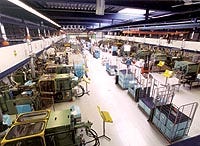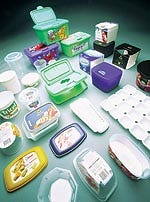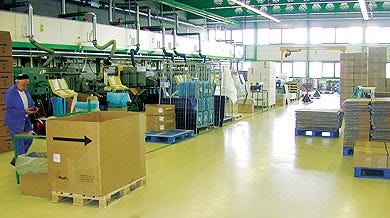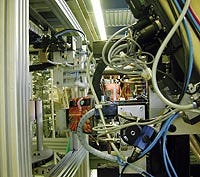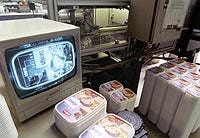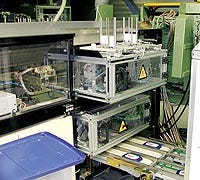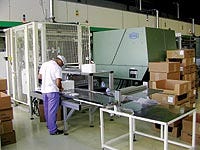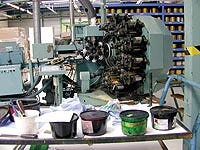Plant Tour: Sharing markets and technology in a multinational marriage
September 1, 2001
|
The molding plant for food applications is clear of corrugated packaging, and all resin and colorant handling takes place on the mezzanine above the machines so that there is not a single resin pellet on the floor. Hats and lab coats are standard. |
U.S.-based Precise Technology has been on a strong growth track for years. A while ago it looked at its customer list and saw many multinationals. Wanting to serve its clients wherever they were located, the company decided to enter Europe. Moreover, it wanted to do so in a way that would form a base for future expansion. One logical path was to find an existing company in Europe that would make a good fit. Phaff BV of Zevenhuizen, the Netherlands, seemed to fit that bill nicely.
Gerry Duggan, vp of business development at Precise, says being a good fit is putting it mildly. Both companies focus on packaging, both have expertise in automated high-speed, thin-wall production with stack molds and inmold labeling, and both have full design services. Where the companies do not match, each has something to offer the other.
Precise makes molds and runs profitable CAP (customer aligned production) facilities, while Phaff designs and builds its own automation and has blowmolding and offset printing operations. Fifteen km north of Rotterdam, Phaff makes a fine entry point to Europe, and probably best of all, these companies already knew each other. Mike Farrell, executive vp at Precise, had worked with Rob Phaff, owner of Phaff BV, on several projects over a period of about three years.
In May 2000, the acquisition of Phaff BV by Precise Technology Inc. was consummated and the merging of the companies began. IMM recently visited Precise-Phaff, as it is now known, and it is safe to say that the marriage is working out well. Talking with Duggan and Plant Manager Theo Helsloot makes it clear that what the two companies have in common, primarily the packaging expertise, has been a positive factor.
True, there has been a learning curve, but it's been taken in stride. The main reason for this, says Duggan, is probably the similarity in corporate cultures. Both have a philosophy that involves working hard to gain success and having fun doing it. The prevailing atmosphere at both companies is relaxed and informal, making it easy to deal with each other.
|
In-house labeling and printing capabilities allow Phaff to offer a full-service approach to packaging production. |
Custom Automation Solutions
Phaff BV believes in lean manufacturing and has much experience at it. The company went deeply into automation in 1994 when it decided to get into inmold labeling (IML). It was a technology that fit the company's business strategy and customers' needs perfectly, but Phaff was not happy with the speed and performance of the robotics it saw. They all were too slow, the company thought, especially for thin-wall packaging.
Therefore, Rob Phaff and his staff began designing and building their own robot systems, which were at least 5 to 10 percent faster than then-current systems. The first robot the team built is still running, though it will be deinstalled to make way for a faster solution when the current product run stops. Phaff's robotics have become even faster and are now sophisticated enough to be called automation systems.
Phaff's chief goal for automation has always been process stabilization, even more than speed. Of course, not all the automation in the plant has been built in-house. The six newest Netstal systems are equipped with custom takeout and handling systems. Helsloot says that in the future more automation will likely be supplied by outside sources. But no matter their origin, all automation systems must continue to meet Phaff standards. In general, the company's experience with robot, handling, and vision systems means it can collaborate with a supplier for an optimum system, rather than selecting an off-the-shelf unit.
|
This container presented a challenge because foam IML had to go around three sides, two of which were double curved. |
Specialized Environments
Phaff does not limit optimization to automation. Its injection molding areas are also designed to cater to specific applications. The injection molding factory is actually two separate plants, one of which is optimized for food packaging. The second is for nonfood packaging. There are 23 machines in the food room; 15 in the nonfood room. Both are very clean but there are some obvious differences.
The food product plant has no corrugated packaging on the floor to carry dust and other particles. Nor is metal, other corrugated material, or glass allowed in the facility. All hydraulic oil is FDA approved. Hats and lab coats are mandatory, even for visitors. A metals detection/removal system mounted inline on the material input conduits that feed into the food product molding area traps ferrous and nonferrous metals. Automation systems permit molded and labeled products to exit the plant untouched by human hands.
Phaff is very aware that its products will contain food and that its packages must reflect the customer's image and reputation. None of this is compulsory, says Helsloot, but it provides customers with an enhanced sense of security.
In both plants there are no raw materials, including master batch colorants, on the molding floor. All resins and Motan material handling hoppers reside on a mezzanine above the machines. Central dryers are on the other side of the wall separating the molding rooms from the warehouse where material is received.
Each of the two molding plants within the factory can compensate if the other is disabled. They have duplicate systems for air, water, power, and material drying and handling. Should there be a problem that closes one plant, a critical customer order can still be produced in the other.
|
The general purpose molding plant allows corrugated packaging onto the floor. The two plants are divided by a wall but each has its own support systems, and if one is inoperable for some reason the other can continue to meet customer orders. |
|
IML at Center Stage
Phaff and Precise each began doing IML to give customers a choice and an advantage. The quality of inmold-decorated packages is far superior to most other technologies. Images of food can be photo-realistic and made to look much more appealing to consumers.
Still, IML is not easy. Going around corners and over curves creates even more of a challenge. Using its skills in design and production, Phaff has found solutions that allow, for instance, a foamed IML to go around three sides of a food tub with double curved walls.
That solution now makes a great-looking package in sub-6-second cycles. Phaff also has a solution for customers wanting labels around circular tapered-wall containers. It built an automated system that first wraps the label around a mandrel on the insertion robot's EOAT, and then places it in the cavity, positioning it perfectly without wrinkles.
|
|
For online quality monitoring of inmold labels, Precise-Phaff engineers coupled a self-teaching vision inspection system (above, left and right) with takeout/handling robots (bottom right). The vision system and all robotics seen are engineered in-house. | |
|
|
This Motan materials handling system is for the molding room that produces food-grade products. There is a second system for the other molding plant, including separate outside silos. |
|
More With Printing
Phaff BV started as a printing company and brought a lot of that skill into package decoration. Besides IML, it offers hot stamping, screen printing, and something you rarely see in a molding operation: offset printing. There are six lines that can print four to six colors at speeds up to 400 pieces/min. Curing is done by inline UV or IR stations. The products printed are mostly round, but can also be rectangular. The image quality cannot match inmold labels, but there is a good market.
Even though IML and offset printing seem complementary, a gray area of cost and quality exists between the two systems. Setup of an offset press is faster than establishing an IML system. However, changing the IML label without changing the mold—something done frequently—is much faster than changing out an offset system. Helsloot says that as IML technology has improved its cost has gone down. That plus IML's quality combine to create a trend away from offset toward IML. Even stadium cups are moving to IML as prices fall.
Helsloot says offset printing may be phased out sometime in the future, but certainly not in the near term. The combination of IML and offset means Phaff offers packaging clients a wide range of options. Food marketers in particular have different strategies for products that sell at different price points. Lower-cost products usually do not need the quality of a preprinted label, but they certainly need lower-cost packaging.
|
|
This air freshener package for S.C. Johnson is made in a 4+4 stack mold to equalize lids and tubs. Automation is by Phaff. Both Precise and Phaff have long-term experience with stack molds. | Begun as a printing company, Phaff has maintained an edge in package decorating. It has five of these multicolor offset printing lines and can print on rectangular packages. |
|
|
The flowerpots are a proprietary product where virtually all of the company's production scrap is recycled. Made in white and terra-cotta colors, the pots turn material unusable in food packaging into a profit center. | Building its skills in product and mold design lets Precise-Phaff provide total process support to its packaging clients and has enabled production of some IML packages previously thought impossible. |
Bringing It All Together
What, we asked Theo Helsloot and Gerry Duggan, were the difficulties in putting the cultures of Precise and Phaff together? Learning different computer systems and the differing EU and U.S. regulations were mentioned, but both said these were details, not problems. Overall, there seemed to be no major difficulties. Why not? Both men pointed to the shared markets and technologies, similarities in corporate cultures, and one other factor: language.
English language skills in the Netherlands are strong. The reasons include school programs, a lot of original language TV and film programming, but most of all the enthusiasm for being world citizens that has always been a hallmark of the Dutch.
When Precise Technology's CEO John Weeks came to Zevenhuizen to discuss the acquisition with Phaff employees, he spoke to them in English—and virtually all of them understood him without a translator. If you think that is not an advantage, try doing the opposite some time.
There is some good-natured intercultural teasing, but it is meant to induce a smile. A great example is provided by Rob Phaff himself. Organizationally, Phaff is part of the central R&D operation based in the U.S., so he is in America frequently. Near the door to his office at Precise-Phaff is a small replica of the sign that stood on the American side of Checkpoint Charlie when Berlin was a divided city. In several languages it says, "You are now leaving the American sector."
Vital Stats |
Precise-Phaff, Zevenhuizen, The Netherlands |
Plant size: 11,000 sq m |
Contact information |
You May Also Like
